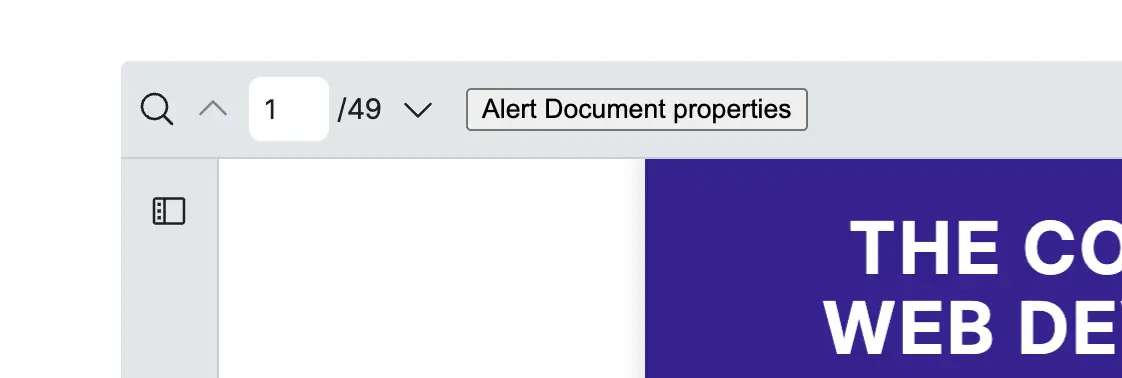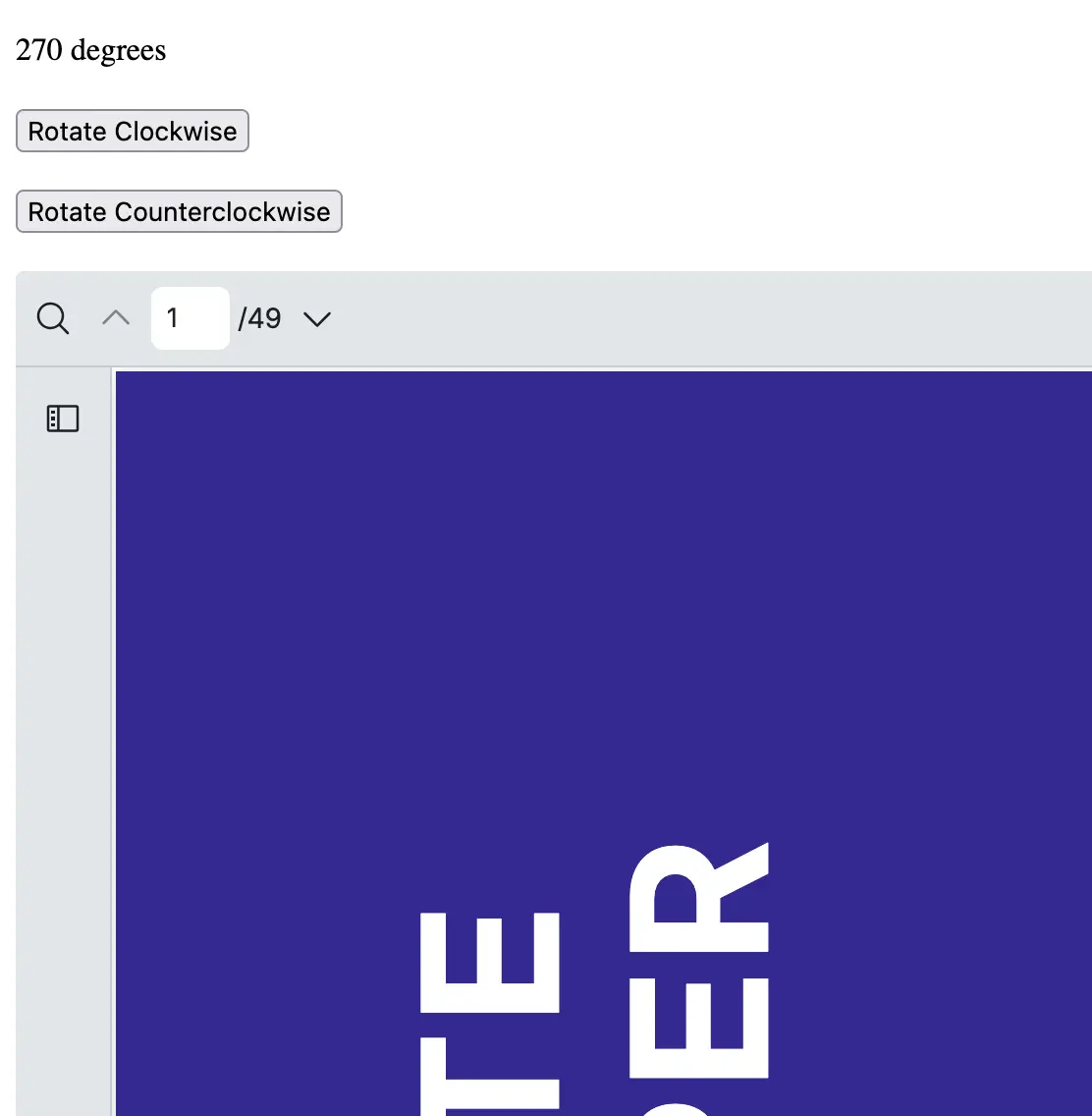Create Your Own Toolbar
Certain tools within the toolbar and the More Options menu expose a React Context API, enabling advanced control and customization. These APIs allow users to interact with and modify the behavior of specific tools directly from the parent component.
The methods are exposed through React’s hooks and can be accessed via a ref in the parent component. This setup allows users to dynamically trigger actions, such as adjusting zoom levels, toggling visibility, or navigating pages. For a detailed list of available configuration options, refer to the Hooks documentation.
Add a Custom Button on the Toolbar
Section titled “Add a Custom Button on the Toolbar”The toolbar accepts components, which means you have full flexibility to arrange, modify, or reorder its components however you like.
Example: Add a Button to Toolbar and Show the Document Properties
Section titled “Example: Add a Button to Toolbar and Show the Document Properties”React PDF provides a useDocumentContext through its React Context API, enabling you to know what properties a PDF file currently has.
Here is a simple button example that will help you place a button on your toolbar. When you click on the button, it will show the Document properties.
import { RPConfig, RPProvider, RPLayout, RPPages, SearchTool, PreviousPageTool, InputPageTool, NextPageTool, ThumbnailTool, useDocumentContext} from '@pdf-viewer/react'
const DocumentPropertiesButton = () => { const { pdfProperties } = useDocumentContext()
return ( <div style={{ marginInline: '8px' }}> <button onClick={() => alert(`${JSON.stringify(pdfProperties, null, 2)}`)}> Alert Document properties </button> </div> )}
const AppPdfViewer = () => { return ( <RPConfig> <RPProvider src={'https://cdn.codewithmosh.com/image/upload/v1721763853/guides/web-roadmap.pdf'} > <RPLayout toolbar={{ topbar: { component: ( <> <SearchTool /> <PreviousPageTool /> <InputPageTool /> <NextPageTool /> <DocumentPropertiesButton /> </> ) }, leftSidebar: { component: <ThumbnailTool /> } }} > <RPPages /> </RPLayout> </RPProvider> </RPConfig> )}
export default AppPdfViewer

Add a Custom Button in a Parent Component
Section titled “Add a Custom Button in a Parent Component”With the Context API, you can invoke key features like rotating pages, zooming, or navigating through the document without relying solely on the viewer’s built-in UI. This approach is particularly useful for users who need to customize specific designs or meet unique usability requirements.
Example: Add an External Button to Rotate PDF
Section titled “Example: Add an External Button to Rotate PDF”React PDF provides a useRotationContext hook, enabling you to control page rotation from outside the viewer. This flexibility allows you to integrate rotation controls into custom buttons or external components, making the viewer adaptable to your application’s needs.
import { useRotationContext, RPConfig, RPProvider, RPLayout, RPPages} from "@pdf-viewer/react";
const CustomRotationLayout = () => { // Access the rotation control from the context const { rotate, setRotate } = useRotationContext();
// Rotate 90 degrees in a clockwise direction const handleRotateClockwise = () => { setRotate((prev) => (prev + 90) % 360); };
// Rotate 90 degrees in a counterclockwise direction const handleRotateCounterclockwise = () => { setRotate((prev) => (prev - 90 + 360) % 360); };
return ( <div> {rotate} degrees <br /> <button onClick={handleRotateClockwise}>Rotate Clockwise</button> <br /> <button onClick={handleRotateCounterclockwise}> Rotate Counterclockwise </button> </div> );};
export const AppPdfViewer = () => { return ( <RPConfig> <RPProvider src="https://cdn.codewithmosh.com/image/upload/v1721763853/guides/web-roadmap.pdf"> <CustomRotationLayout/> <RPLayout style={{ width: "100%", height: "550px" }} > <RPPages /> </RPLayout> </RPProvider> </RPConfig> );};import { useRotationContext, RPConfig, RPProvider, RPLayout, RPPages} from "@pdf-viewer/react";import { type FC } from "react";
const CustomRotationLayout: FC = () => { // Access the rotation control from the context const { rotate, setRotate } = useRotationContext();
// Rotate 90 degrees in a clockwise direction const handleRotateClockwise = () => { setRotate((prev) => (prev + 90) % 360); };
// Rotate 90 degrees in a counterclockwise direction const handleRotateCounterclockwise = () => { setRotate((prev) => (prev - 90 + 360) % 360); };
return ( <div> {rotate} degrees <br /> <button onClick={handleRotateClockwise}>Rotate Clockwise</button> <br /> <button onClick={handleRotateCounterclockwise}> Rotate Counterclockwise </button> </div> );};
export const AppPdfViewer : FC = () => { return ( <RPConfig> <RPProvider src="https://cdn.codewithmosh.com/image/upload/v1721763853/guides/web-roadmap.pdf"> <CustomRotationLayout/> <RPLayout style={{ width: "100%", height: "550px" }} > <RPPages /> </RPLayout> </RPProvider> </RPConfig> );};